The Portico Earrings Wire Weaving Tutorial
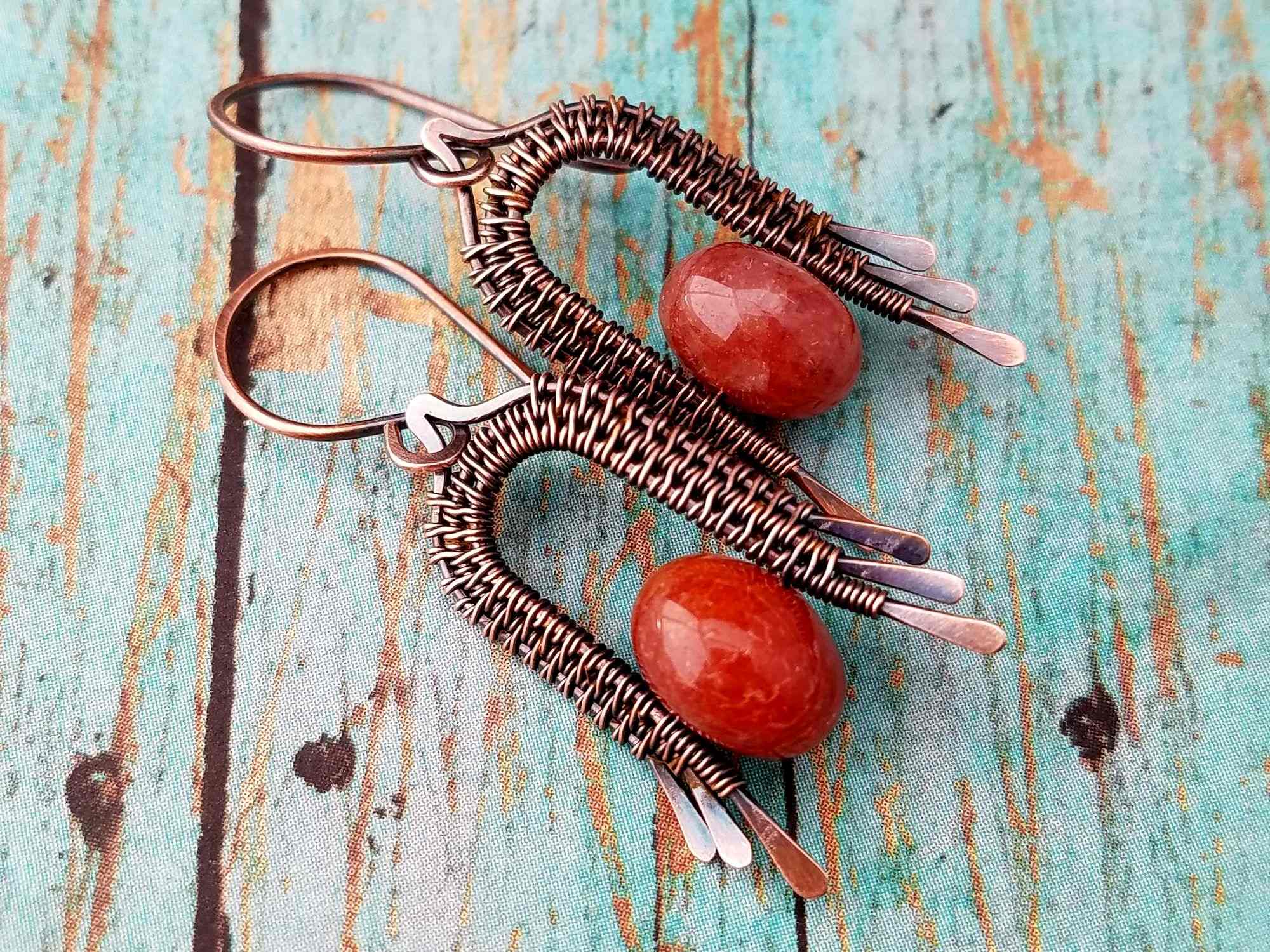
The Portico Earrings are the perfect complement to the Portico Pendant, which as you may recall, was originally inspired by the fanciful covered entry of one of my favorite homes in the historic Old North End of Colorado Springs.
I chose some pretty 7mm x 10mm Rutilated Quartz rondels for this tutorial. I used the same beads in a larger size for the Portico Pendant, and I purchased all these pretty multicolor gemstone beads quite some time ago from an Etsy shop that is currently not stocked. However, you can use nearly any 6-7mm bead for this design. Round beads work just as well as rondels. You can even use large hole rondels for this design (with or without round spacer beads to fill in the holes).
Feel free to experiment with different beads. This design can be easily modified to work with a multitude of bead shapes and sizes.
Copyright & Disclosure
As always, you’re welcome to make and sell products from this tutorial on the condition that you credit Wendi of Door 44 Studios for the design and link back to this page.
When it comes to my written tutorials, however, I reserve exclusive rights to all images and written content. You may not reproduce or redistribute any portion of the Portico Earrings tutorial in any way, shape, or form. Furthermore, you may not teach the designs contained within this tutorial without my written permission.
This copyright applies to the printable PDF version of the Portico Earrings tutorial as well, and it’s included therein. Don’t forget, you may share the free version of this tutorial only by linking directly to this page.
This post may contain affiliate links. If you click on a link and then make a purchase, I may earn a small commission (at no cost to you). As an Amazon Associate I earn from qualifying purchases. To learn more, please see my full disclaimer.
Skill Level: Intermediate
This is a more challenging project that involves wire weaving. It can be achieved by someone who has some basic wirework skills.
Getting Started
You may use half-hard or dead soft solid jewelry wire for the core wires for this design. Because there’s no heat involved, this design will work just as well with brass or bronze wire as it does with copper or sterling silver. As usual, you’ll need dead soft wire in the same (or a compatible) alloy for weaving.
If you choose sterling silver for your core wires, I recommend using dead soft fine silver for weaving. And you’ll also need to modify the way that you suspend your focal beads if you choose silver wire. There’s a free tutorial on my blog that walks you through the modified bead suspension method.
If you choose to use a filled wire, be aware that the bead frames are finished and hardened by hammering the wire. Even light hammering can expose the base metal core in filled wires, which can negatively affect your final finish. As always, I don’t recommend plated or anodized craft wire for this necklace as those coatings will be ruined with this construction process.
related posts
Skills Needed to Complete This Project
How to Choose the Right Jewelry Wire
Jewelry wire is a constant source of confusion for beginners. I remember those days well! If you’d like to learn how to choose the right jewelry wire for wire weaving, be sure to read this post. In it, I share everything you need to know about jewelry wire as you set out on your wire weaving journey.

Tools & Materials
- 20ga wire – 6 inches (15.25 cm)
- 28ga dead soft wire – 6 feet (2 m)
- 6-7mm round or roundel beads (I chose the 7mm x 10mm roundels pictured above right) – 1 each
- Wire Cutters
- Chain Nose Pliers
- Flat Nose Pliers
- Stepped Bail-Making Pliers
- Needle File
- Chasing Hammer
- Bench Block
- 10mm mandrel (I use these knitting needles)
- Ruler
- Fine Point Permanent Marker
- Sharp Beading Awl (optional)
- Nylon Jaw Pliers (optional)
- Sunshine® polishing cloths (optional). These are the polishing cloths that I use for dry polishing jewelry.
Finished Size
- WIDTH: about 5/8 inch (1.59 cm)
- LENGTH: about 1-1/8 inches (4.13 cm)
I added my Basic French Hooks to these earrings to complete the look. Ear wires will add between 1/2-inch (1.27 cm) to 3/4-inch (1.91 cm) to the overall drop length, depending on the ear wires that you choose. The Basic French Hooks are on the low side of that range.
Want a printable version of this tutorial?
How to Make the Portico Earrings
The following instructions assume that you’re using 7mm x 10mm rondelle beads, as specified in the materials list. However, this design can be easily adapted to any round or rondelle beads.
I make recommendations for resizing the bead frame to fit smaller or larger beads in the Variations section of this tutorial. So refer to that section now if you’ve chosen to use focal beads that are substantially larger or smaller than the 7mm x 10mm gemstone beads that I used. Otherwise, proceed with the instructions for the bead frame, as written.
Form the Bead Frame
Step 1
Measure and cut three pieces of 20ga wire at 2 inches.
File the ends smooth, if necessary, and mark the center of each wire with your permanent marker. These 20ga wires are the core wires that make up the bead frame. And they provide the foundation for your bead frame and form the bezel around your focal stones. So you want these wires to be sturdy. Always choose the heaviest gauge wire that makes sense for your focal beads for these foundation core wires.

Step 2
Align the center mark on one of your 2-inch 20ga core wires with the center of the 6mm step on your stepped bail-making pliers. Then bend that wire into a long U shape, as shown.
Make sure the ends of your wire are even as you form the bend.
We’ll call this Wire 1.
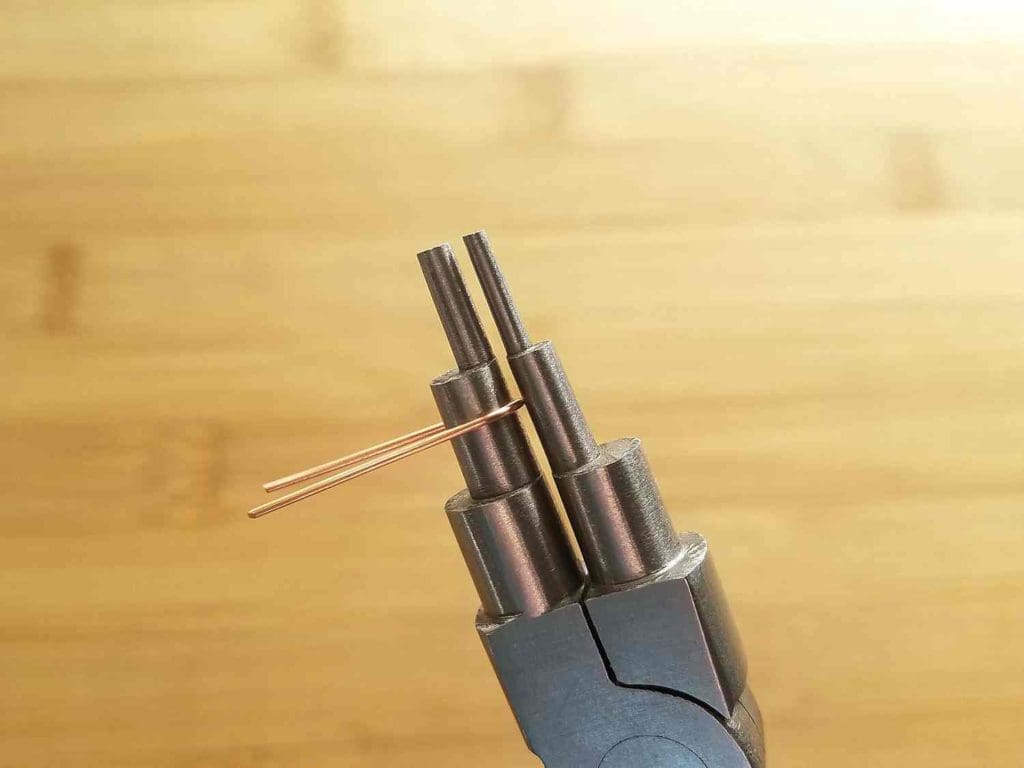
Step 3
Center your second core wire on 8mm step of your bail-making pliers and form an elongated U. Again, make sure the ends of your wire are even with one another.
We’ll call this Wire 2.
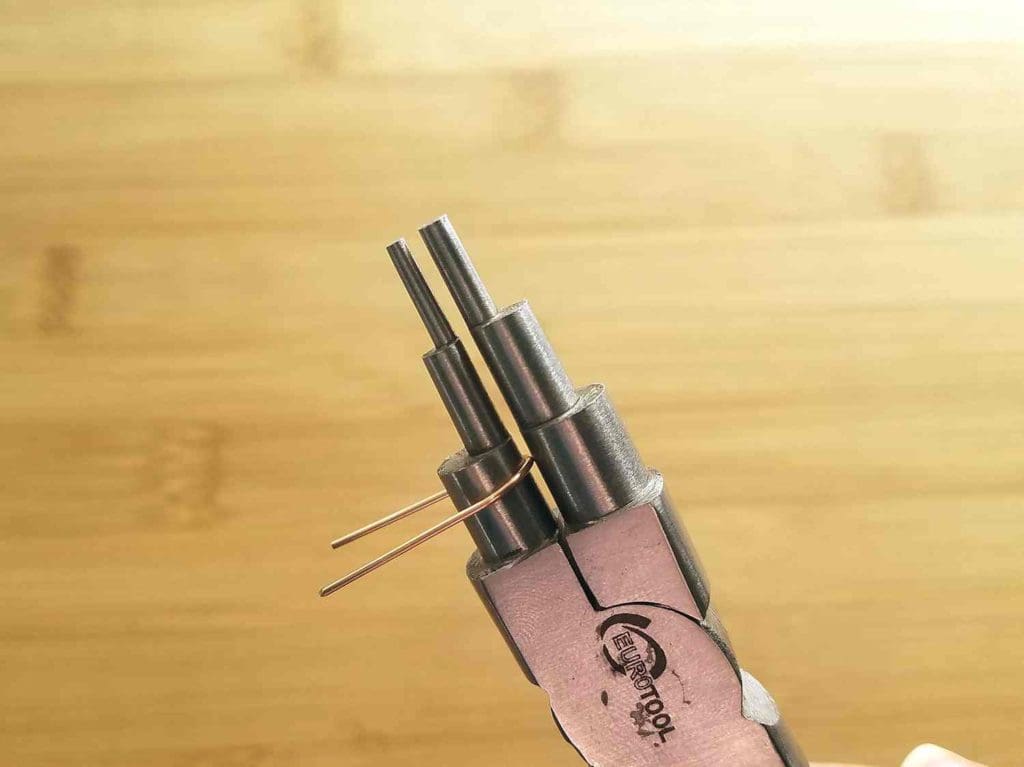
Step 4
We’re now going to shape the third and final core wire. Position one edge your flat nose pliers at the center mark on the remaining core wire.
Then bend the wire firmly with your thumb to form a sharp V in the wire. Again, make sure the ends of your wire remain even.
We’ll call this Wire 3.

Step 5
Continue pressing the wire into an increasingly tighter V. Once the two ends of your wire are nearly parallel, use the tips of your flat nose pliers to tighten the bend until the two wire ends are completely parallel to one another, as shown.
Check the ends of your wire and make sure they’re even at this point. If not, trim the ends with your wire cutters. Then file the ends flat, if necessary, using your needle file.
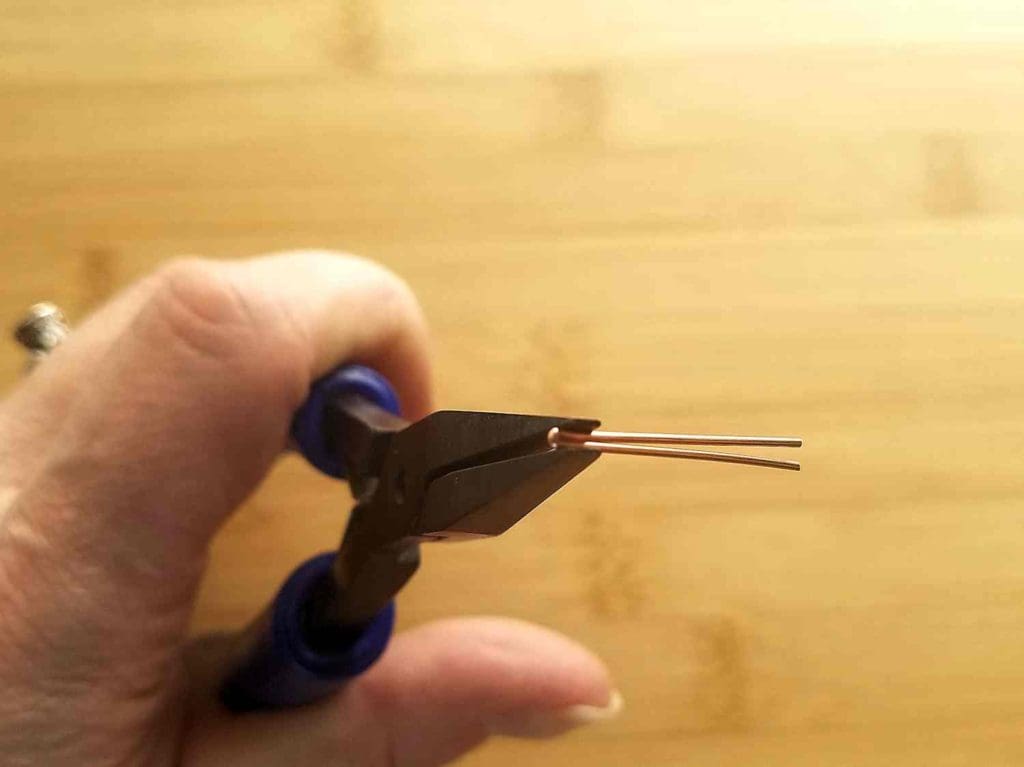
Step 6
We’re now going to straighten Wire 3 before forming the final arch in our Portico bead frame.
Gently pull the ends of the folded wire apart. Use your fingers, as shown, to maintain even curves on either side of the folded point that you made in Steps 4 and 5.

Step 7
Continue to carefully straighten the ends of the wire until it lays mostly flat on your bench surface. Except for the peak in the center of the wire, of course. Your wire should look something like the one shown here when you’re done.
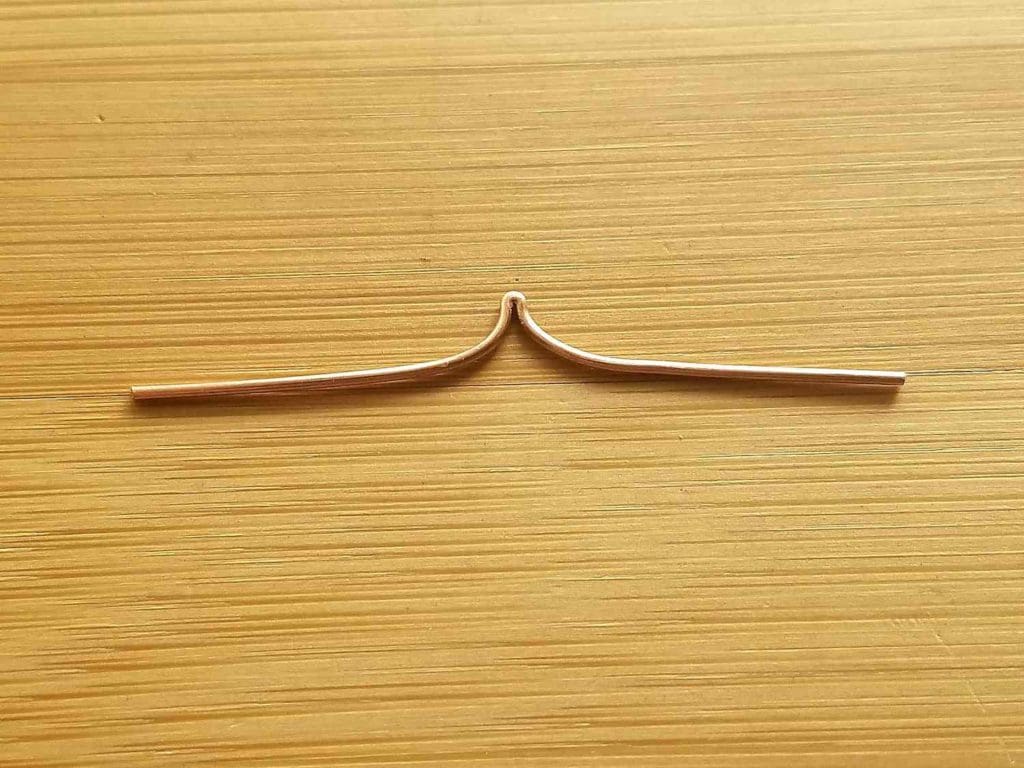
Step 8
Now center the peak on Wire 3 over your 10mm mandrel. Make sure the peak of your wire is centered over the barrel of the ring mandrel. Then form the final elongated U shape on Wire 3, as shown.

Step 9
Now that your three core wires are fully formed, we need to make sure they all fit together symmetrically. So nest your three core wires together with Wire 1 on the inside, Wire 2 in the middle, and Wire 3 on the outside. Then make any necessary adjustments until your three wires nest neatly together, as shown.
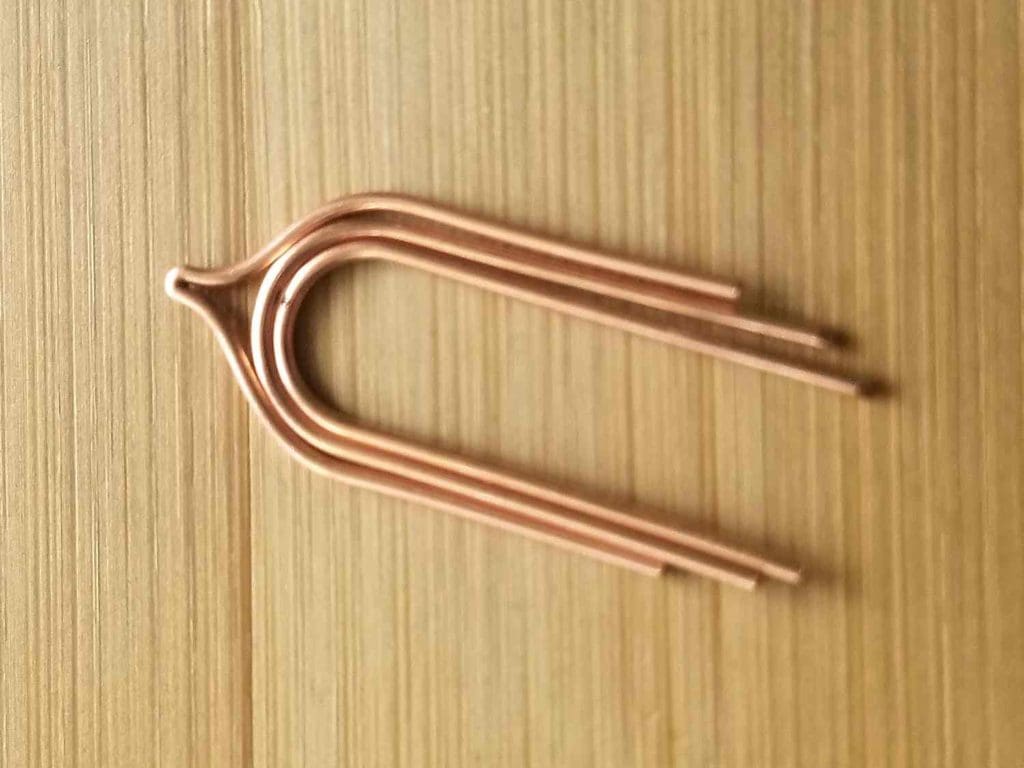
Step 10
Next, we’re going to make sure the ends of the core wires are stepped evenly. Leaving the three wires nested together, carefully examine the ends of the wire. Make sure the steps are symmetrical from Wire 1 to Wire 3. If not, trim and file the ends as needed. And make sure that the two ends of each individual core wire are even with one another. Also, make sure the ends are evenly spaced across the three wires.

Step 11
Now that your three core wires are refined and ready for the final step, we need to mark some weaving reference points. Using your fine-point permanent marker, mark the three core wires on either side of the peak on Wire 3, as shown.
These points indicate where the weave will incorporate Wire 3 on either side of the bail peak.

Step 12
Use your chasing hammer and bench block to paddle the ends of all three core wires and the pointed bail on Wire 3. Smooth and shape the ends with your needed file, if needed.
Your three core wires should look something like those shown in this image when finished.
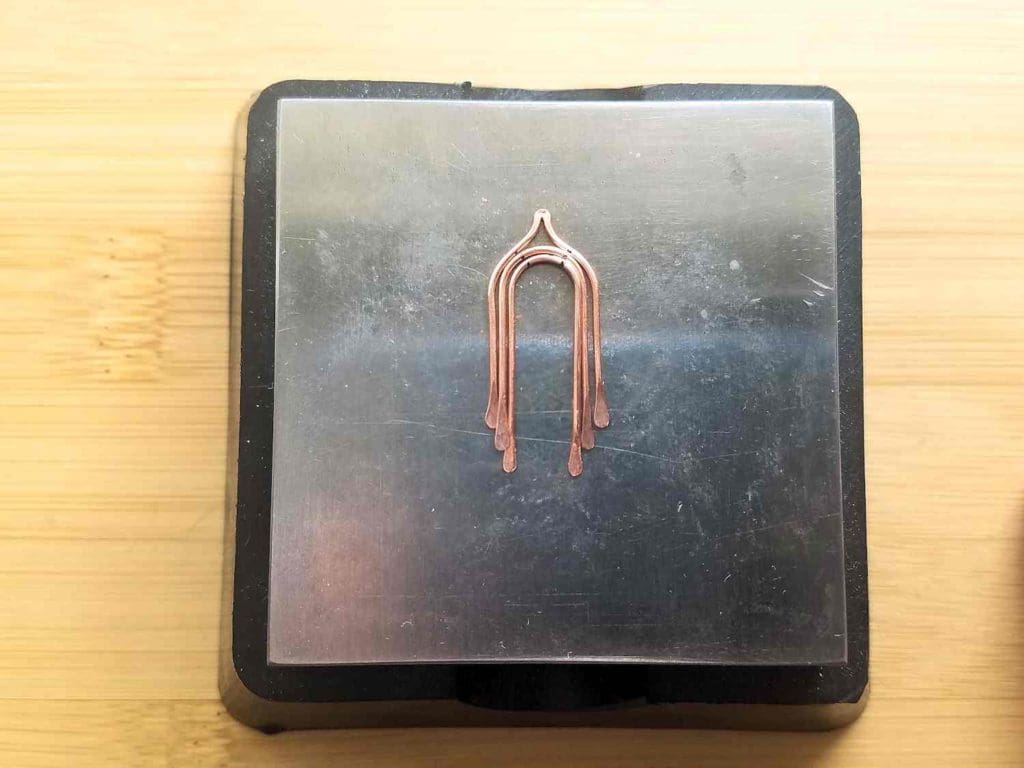
Weave the Core Wires Together
Step 1
You’ll need about 3 feet of dead soft 28g wire for weaving on each earring. I like to work off a bobbin. Just wind your bobbin with more than enough wire to complete the weaving for this project.
I usually wind my bobbins with between 50 and 100 feet of wire. And then I use that bobbin for multiple projects.
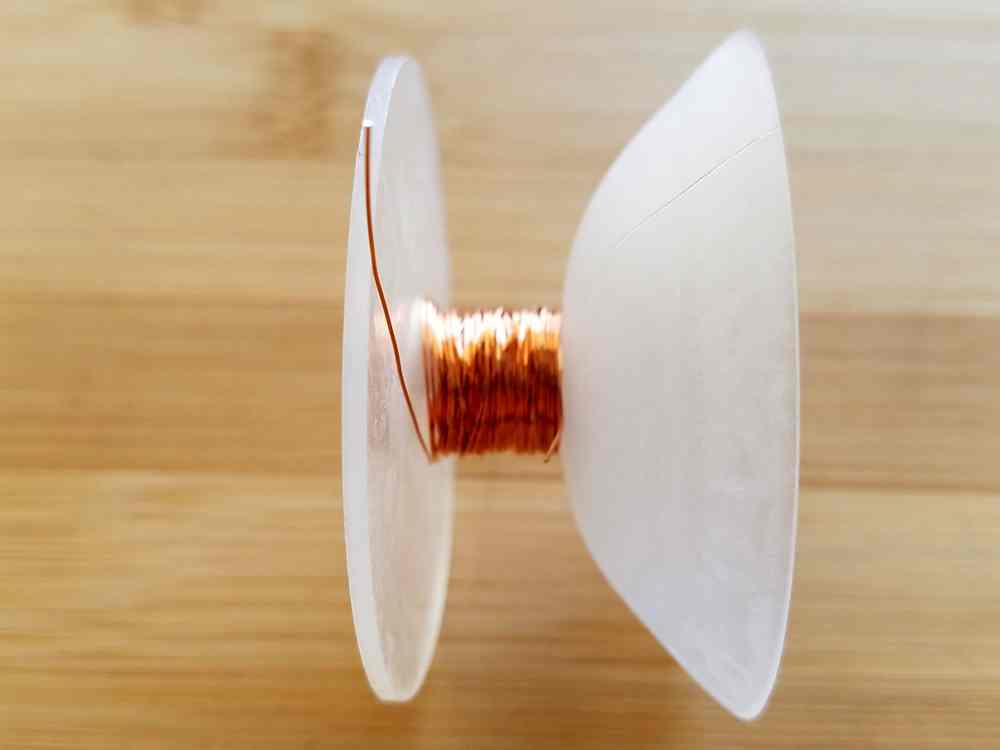
Step 2
Pull about 18 inches of wire off your bobbin, but don’t cut the wire. Then nest Wires 1 and 2 together and start weaving the two wires together at the center point of the bend.
Weave in one direction to the marks you made in Step 11 of the previous section. Then flip your two core wires over and weave in the other direction to the other marks made in Step 11.
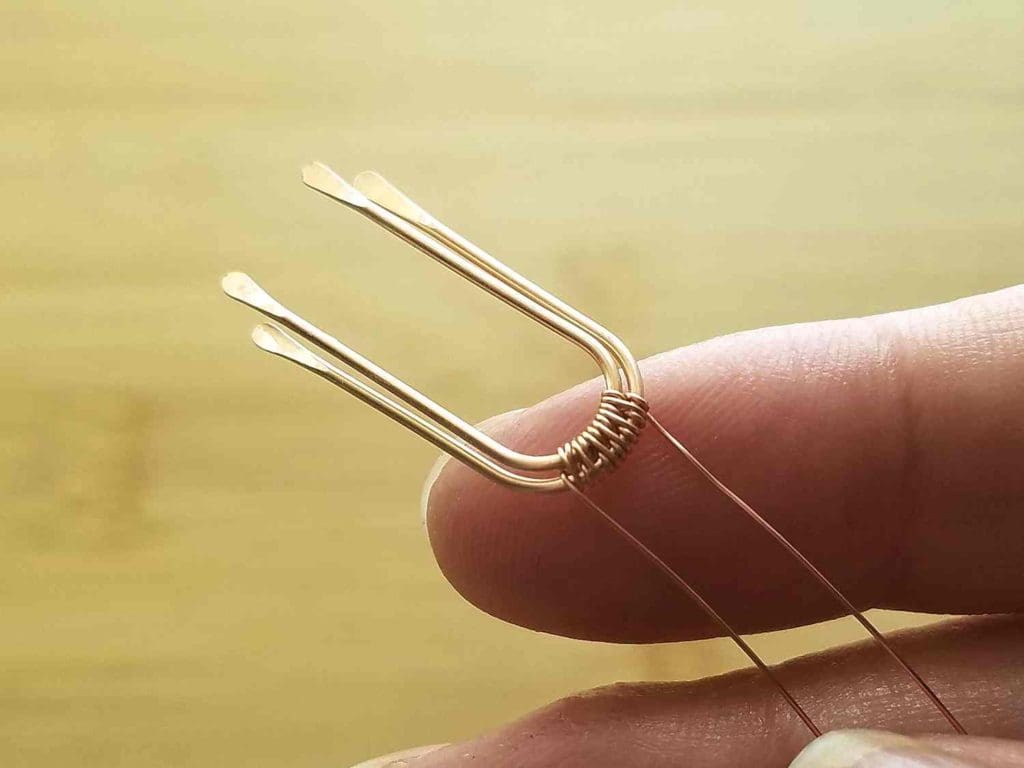
Step 3
Place Wire 3 in position around Wire 2. Continue weaving all three wires together from this point forward.
Complete about six full pattern repeats on both sides of your bead frame so that Wire 3 is fully secured in place.
Your bead frame should now look something like the one shown here.
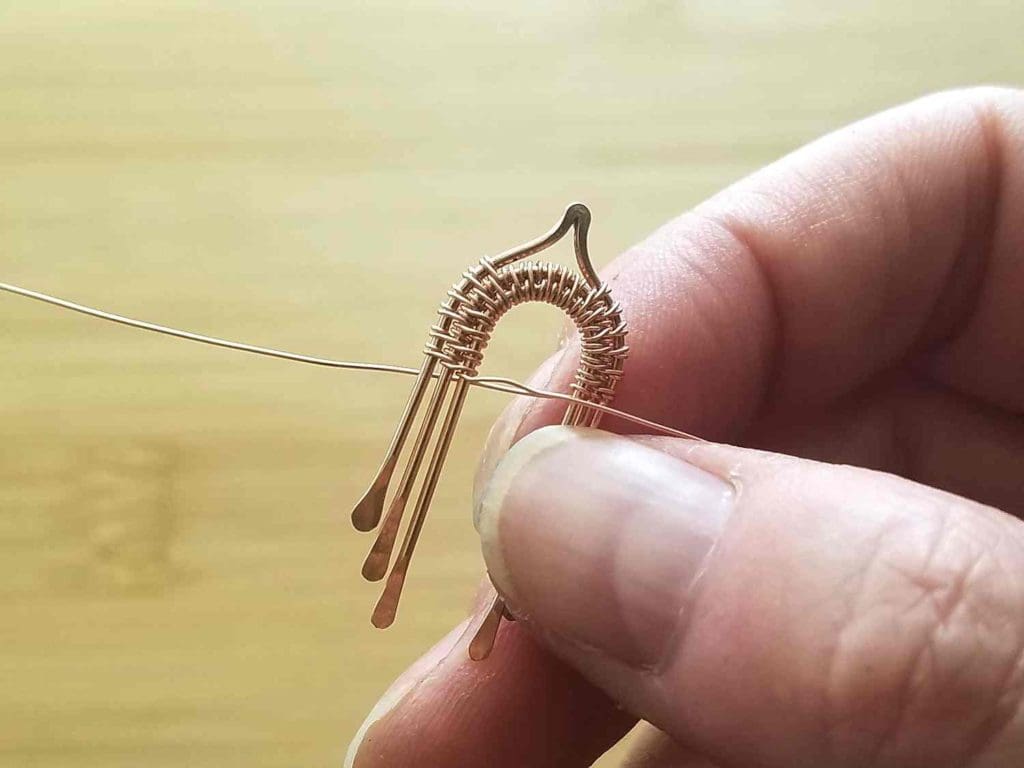
Step 4
Using a straight piece of scrap wire, position your bead on the Portico bead frame to determine at what points you need to thread your weaving wires through the bead.
I positioned mine so that the hole of the bead lined up with the top of the paddled ends of Wire 3. Then use your fine-point permanent marker to mark those points on both sides of Wire 1.
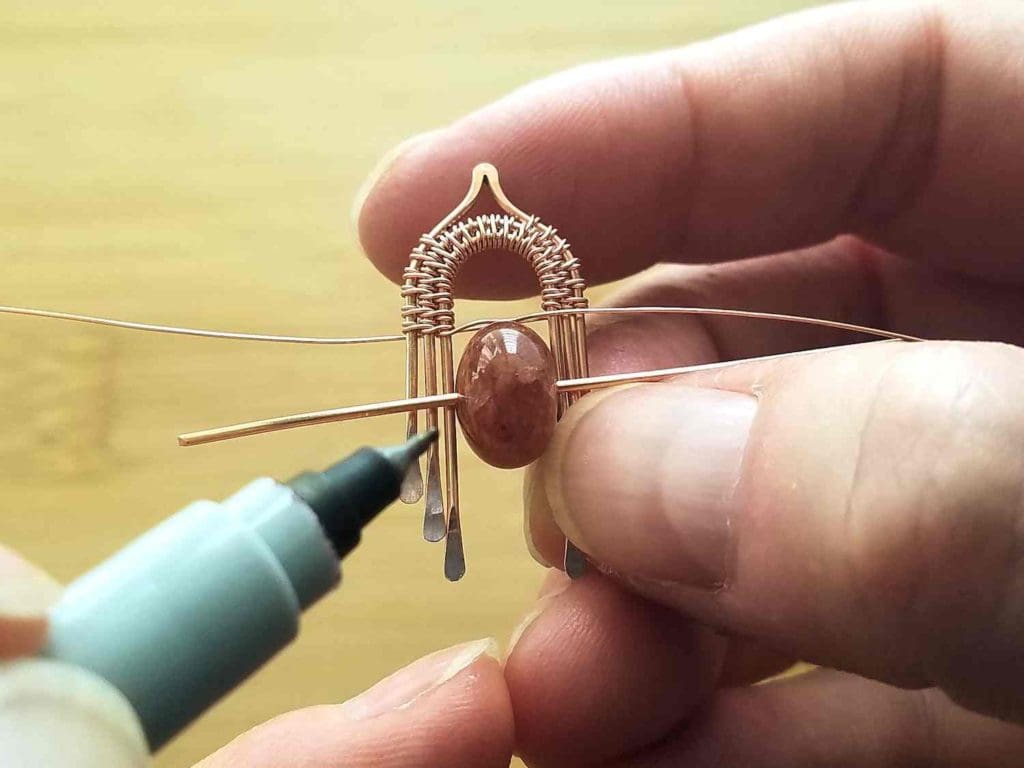
Step 5
Continue weaving in pattern on both sides of your bead frame until you reach the marks you made in the previous step.
Your bead frame will look something like this when you’re done.
Notice that one wire comes out on top of Wire 1 while the other comes out under Wire 1. Pay attention to these wire positions so you can continue your weave seamlessly after suspending your focal bead within the frame.
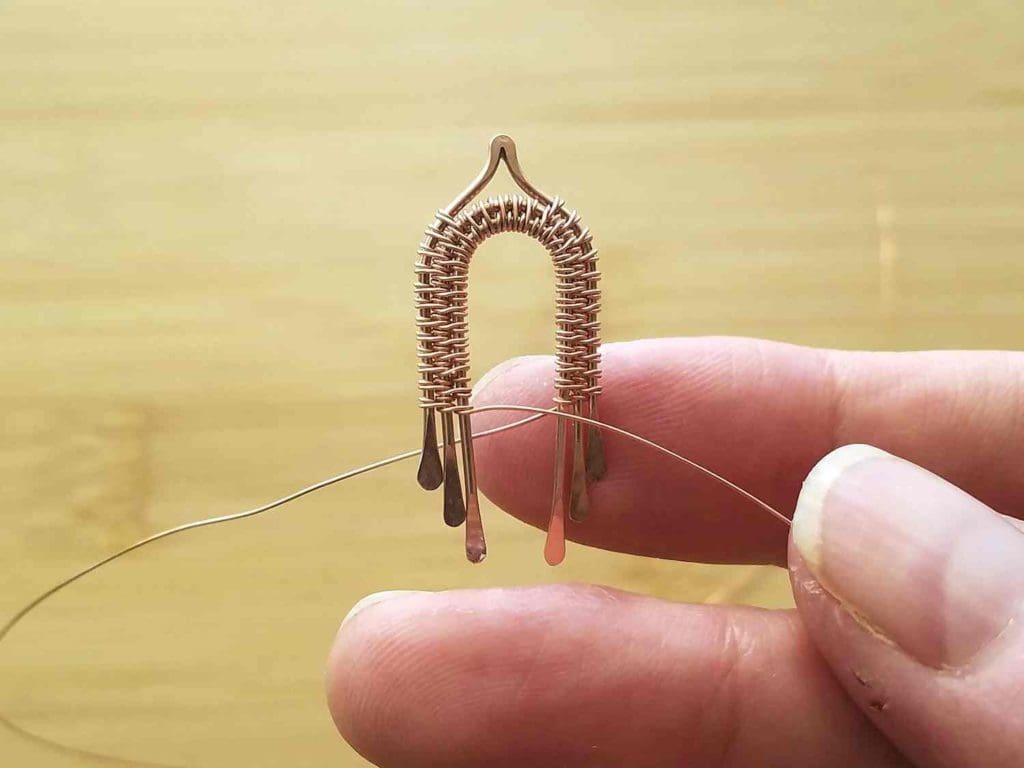
We’re now going to suspend the focal bead from the frame by adding it seamlessly into the weave.
This part takes some patience and determination the first time you do it. So work slowly and carefully to avoid creating kinks in your weaving wire. Otherwise, you’ll compromise the strength of your weaving wire.
Step 6
Again, one end of your weaving wire should be in front of Wire 1 while the other is behind Wire 1. Pay close attention to this pattern because you’re going to continue the weave exactly where you left off after passing each end of the weaving wire through the hole on the bead.
Place your bead flat on the table within your Portico bead frame. Take the weaving wire on the left side of the bead frame and pass it from left to right through your first focal bead.
Repeat on the right side of the bead frame, passing the wire through the first focal bead from right to left.
You should now have two wires passing through your bead, as shown.

Step 7
Gently pull both ends of the wire until your bead slides up into position within the bead frame.
Work the bead into position slowly and carefully to avoid creating kinks in your wire. Once the bead is in place, pull both ends of the wire until the bead sits snugly in the frame with no slack in the wires, as shown.

Step 8
If the hole on your focal bead will accommodate four passes of wire, complete one full weave pattern repeat and then pass each end of your weaving wire through the beads again, just as you did in Step 6.
Again, go slowly to keep your wire from forming kinks. Once both ends of the wire have been successfully threaded through the bead, continue your weave seamlessly where you left off.
If your bead won’t accommodate four passes of wire and you’re confident that two passes will bear the weight of your bead (my beads won’t and I am), continue to the next step. Otherwise, consider using the alternate bead suspension mentioned in Step 4 above. You’ll find a free tutorial for that alternate focal bead suspension method here.
Step 9
Once your bead is secure, keep weaving in pattern on both sides of the frame until you reach the top of the paddled ends on Wire 3. Then reduce your weave to just Wires 1 and 2, as shown.
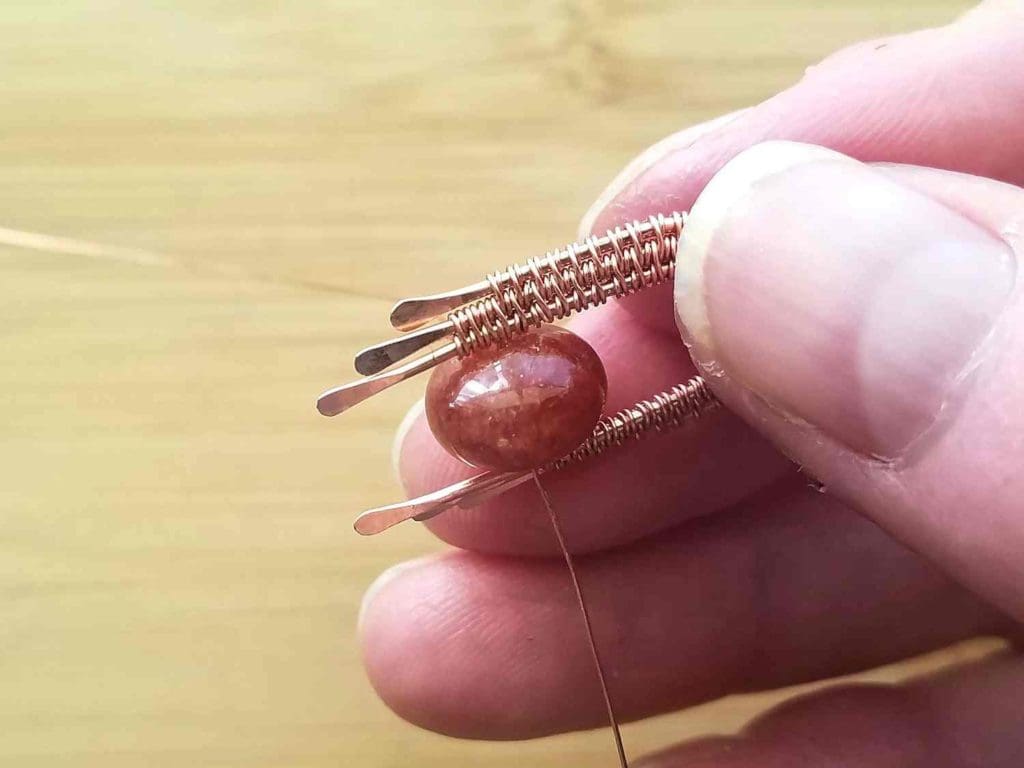
Step 10
Continue weaving Wires 1 and 2 together until you reach the top of the paddled ends on Wire 2.
Then coil the weaving wire around Wire 1 until you reach the top of the paddled end on that wire.
Finally, break your weaving wire where it passes between Wires 1 and 2. Repeat Steps 9 and 10 on the other side of the bead frame.
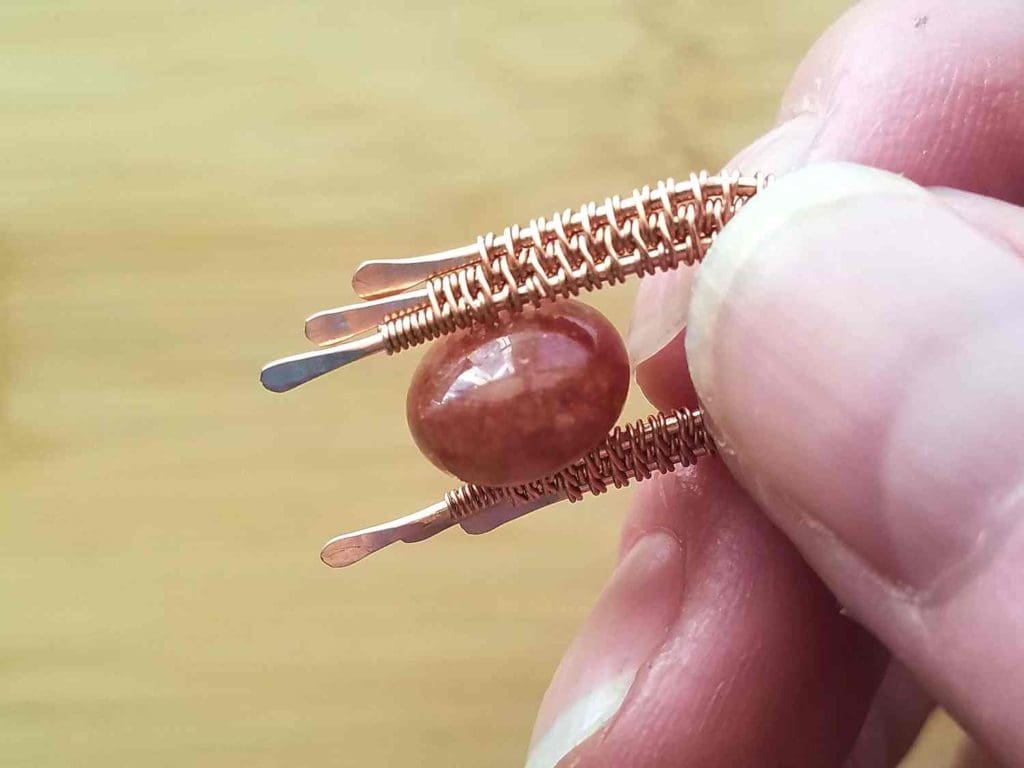
Step 11
The core wires of your bead frame may naturally slip into a convex curve as you’re weaving the frame. But once the weaving is complete, we need to lock in that shape. This creates a bezel effect around the focal bead.
Use your fingers to gently push Wire 1 forward and Wire 3 back. Once you’re satisfied with the shape of your bead frame, use your chain nose pliers to gently flare the paddled ends of all three core wires outward, as shown.
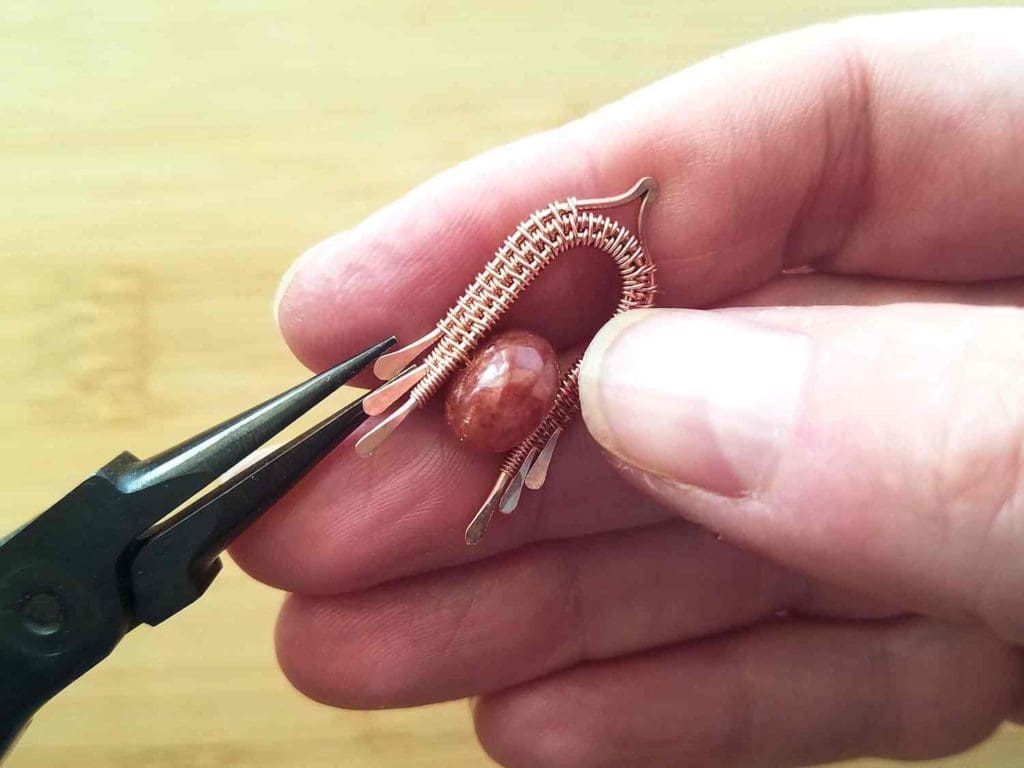
Step 12
Attach an ear wire to your Portico Earring component. These earrings have a distinct front and back face, so be sure you attach your ear wire accordingly.
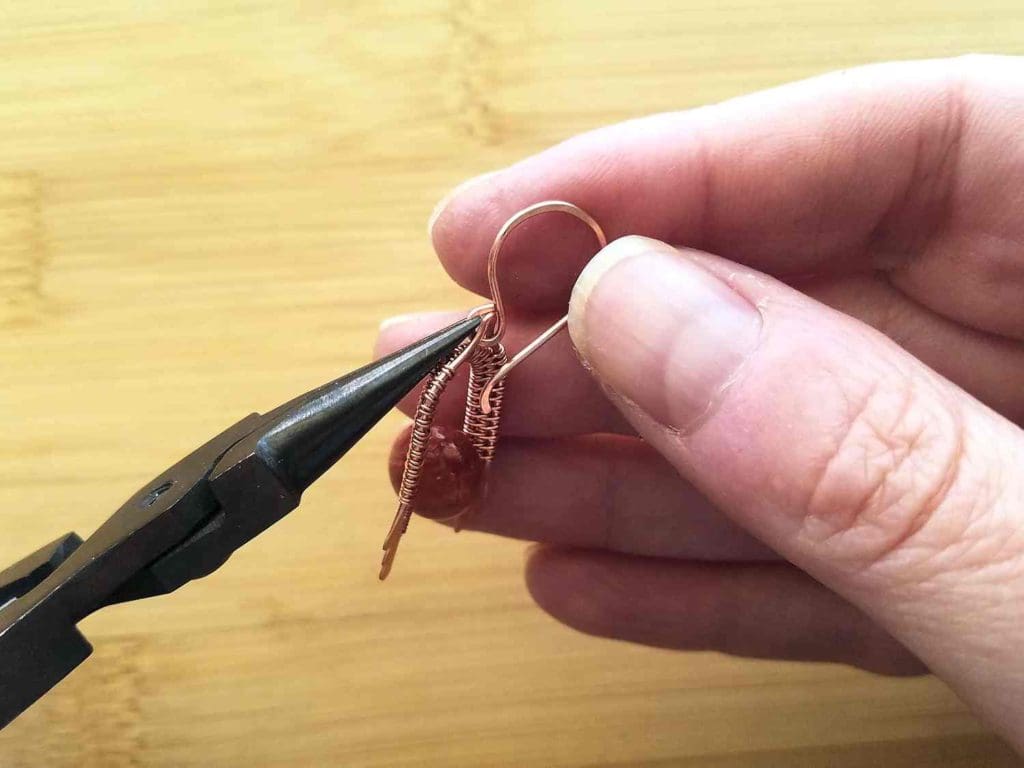
Your first Portico Earring is now complete and ready to patina. Now repeat the instructions from the beginning to complete the pair.
Also, see the Variations section below for some ideas for frame variations that I tested while writing this tutorial.

Variations of the Portico Earrings

Beads that work well for these earrings are easy to locate, and this design can be easily adapted to center-drilled beads of nearly any size and shape.
You can completely change the look of your earrings by simply changing the length of your frame wires to accommodate more beads. You can also resize the frame to fit almost any size beads. Just change the sizes of the mandrels you use to form the curves.
Remember, your goal is to make sure that the size of your bead frame is in balance with the size of your beads. So be sure to consider the size of your core wires when modifying the size of the bead frame.
You can use lighter or heavier gauge core and weaving wires to make a frame suitable for your chosen focal bead(s). I used either 18ga or 20ga core wires with 28ga or 30ga weaving wire for all of the Portico Earrings shown above.
The principles for forming and weaving the core wires are the same regardless of the size of the focal beads. All that you need to change to resize your bead frame are the cut lengths of your core and weaving wires and the size of the mandrels that you use to shape those wires.
You can then fine-tune the gap between your focal beads and your bead frame by using metal spacer beads, if needed. Finally be sure to keep good notes on the ideal lengths for your core wires and mandrels. That way you can easily repeat your modified design.
Add Dimension to Your Portico Earrings
If you’re feeling adventurous, you can modify this pendant in a multitude of ways by cutting even longer core wires and balling the ends of those wires with a torch, as I did on the pair of earrings pictured above center.
Notice that I flipped the Portico Earring components upside down and used the peak of the portico to hang tassels on that variation.
Experiment with this design. I think you’ll find that it’s very versatile. It also works beautifully with a number of other jewelry components like tassels.
Download the Printable Portico Earrings Tutorial
Finishing Your Portico Earrings
I antiqued the Portico Earrings that I made while writing this tutorial with Liver of Sulfur (LOS). Then I burnished the antiqued pieces with super fine steel wool (Grade #0000) in a warm bath of water and original Blue Dawn dish soap. The steel wool brings back the bright copper highlights on the high spots.
Once that’s done, I rinsed my jewelry thoroughly to remove any particles of steel wool. Then I put the freshly washed pieces in tumbler barrels filled with warm water and a generous squirt of Blue Dawn. As a general rule, I tumble each barrel for a minimum of two hours.
Learn More About My Finishing Process
If you’re nervous about finishing your jewelry, be sure to read this detailed tutorial that walks you through my 7-step patina process. And if you’re wondering why I recommend tumble polishing specifically, check out this post as well. Finally, be sure to clean your stainless steel shot regularly. Clean shot is necessary to achieve the best finish on your tumble-polished jewelry.
One last bit of tumbler advice before you go. Always make sure that any beads or stones that you use for your jewelry are safe to tumble. I don’t recommend tumbling natural pearls, soft gemstones, ceramic beads, or glass beads with polymer coatings, such as glass pearls and certain frosted-look glass. Finally, if you’re not sure if your beads can handle the tumbler, run a test tumble with a bead that you’re willing to sacrifice.
Discover More Behind Door 44
Thanks so much for joining me today. I hope you enjoyed creating these pretty Portico Earrings. And if you’d like a printable PDF version of this tutorial, you can find it here.
Would you like more free tutorials and wire weaving tips?
I like to share useful wire weaving tips and tricks on my social media channels, and we have some great conversations about wire jewelry in my private Facebook Group. Also, be sure to connect with me @door44studios on Instagram, and Facebook to keep up with everything that’s happening behind Door 44. And if you haven’t already done so, be sure to subscribe to my YouTube channel where you’ll find new wire jewelry videos weekly.
Until next time, go make something beautiful!

Pin the Portico Earring Tutorial for Later
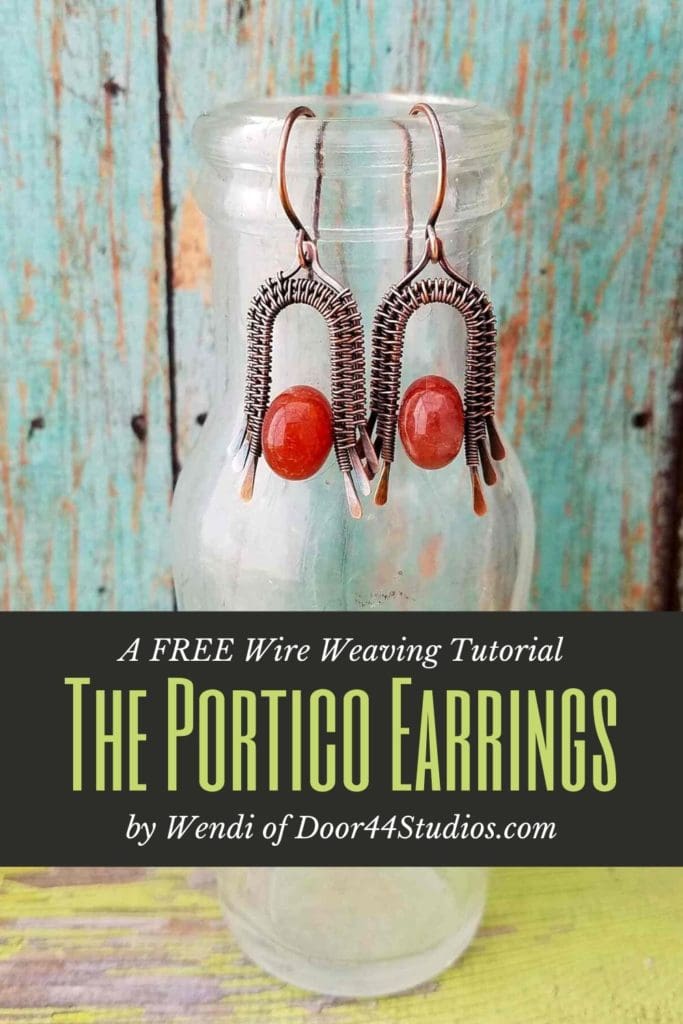

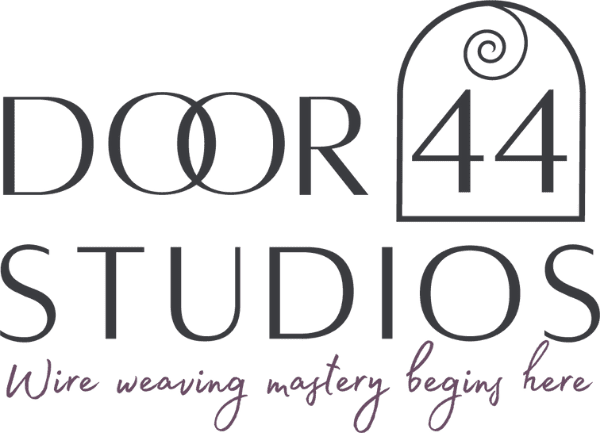


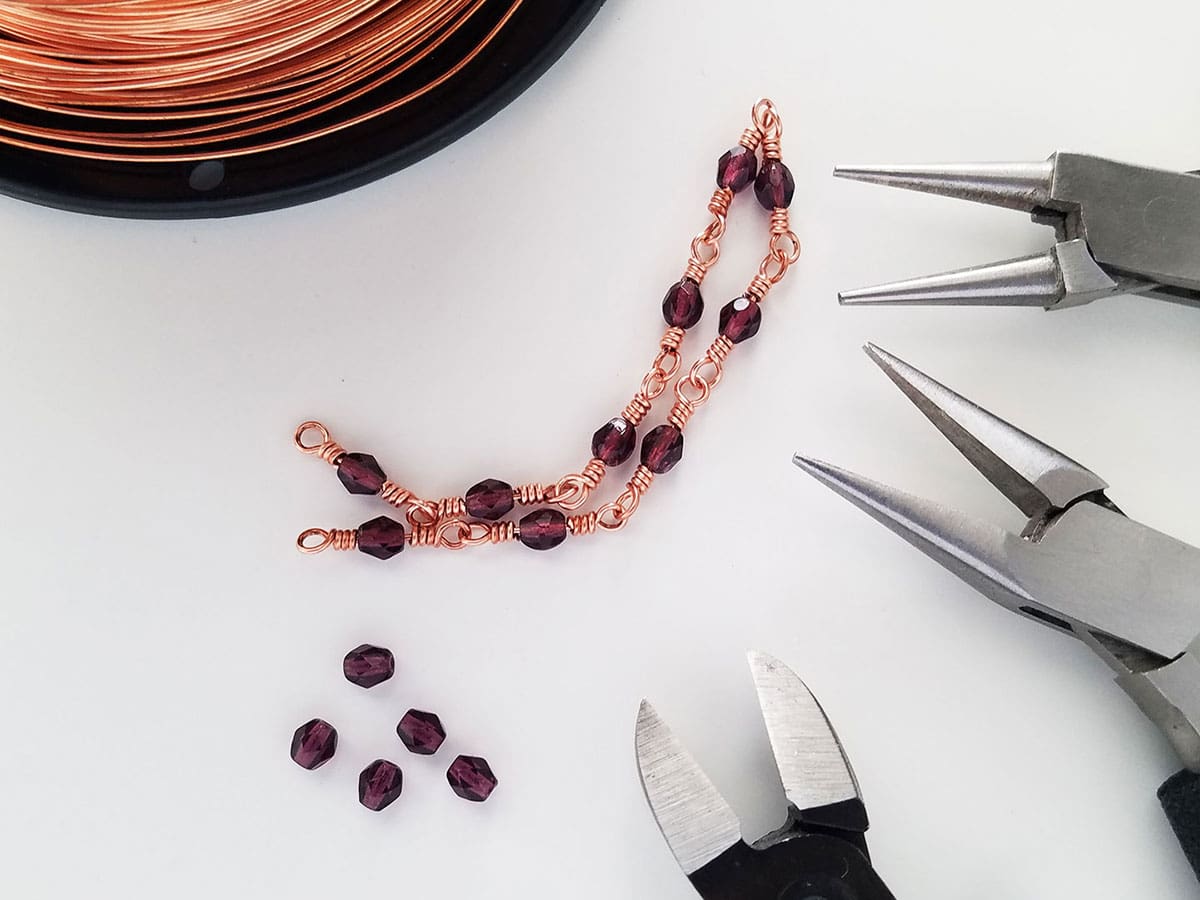

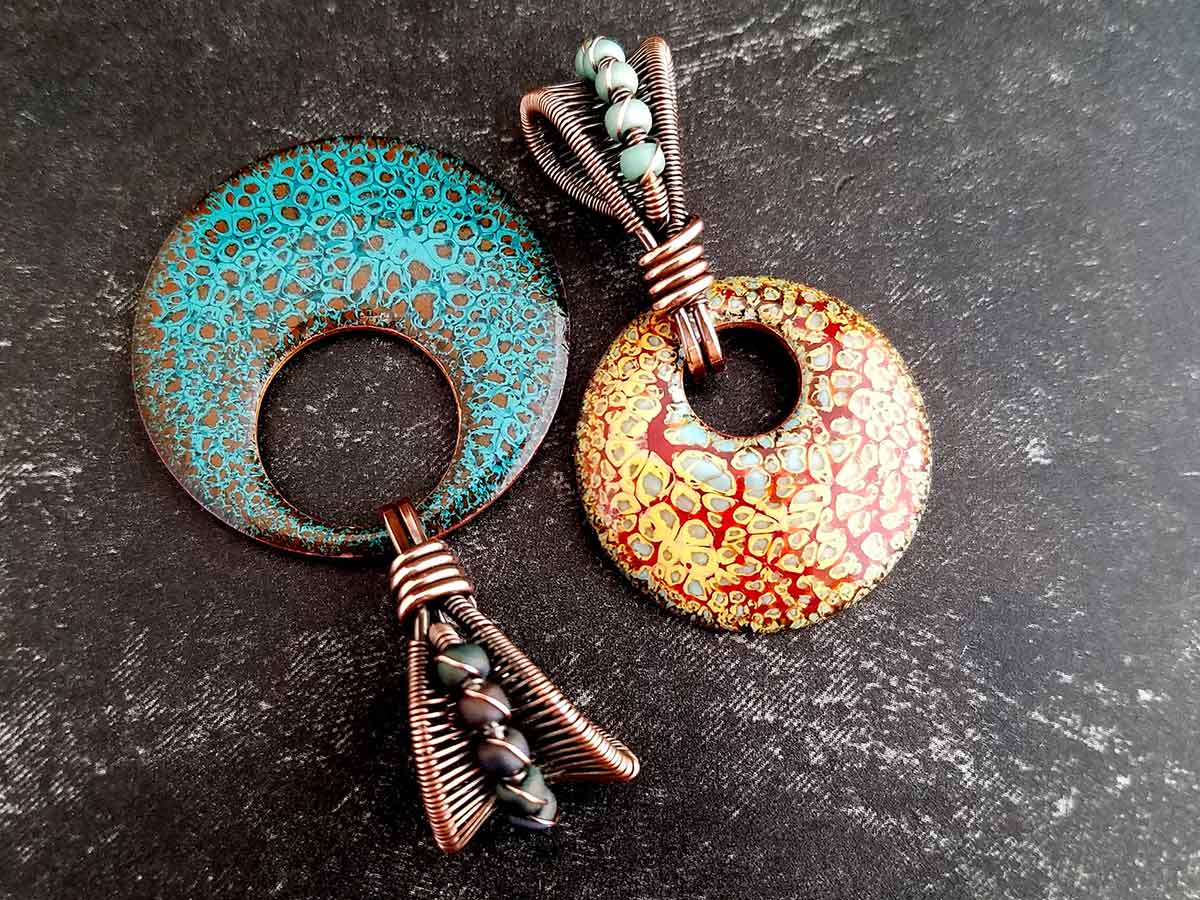
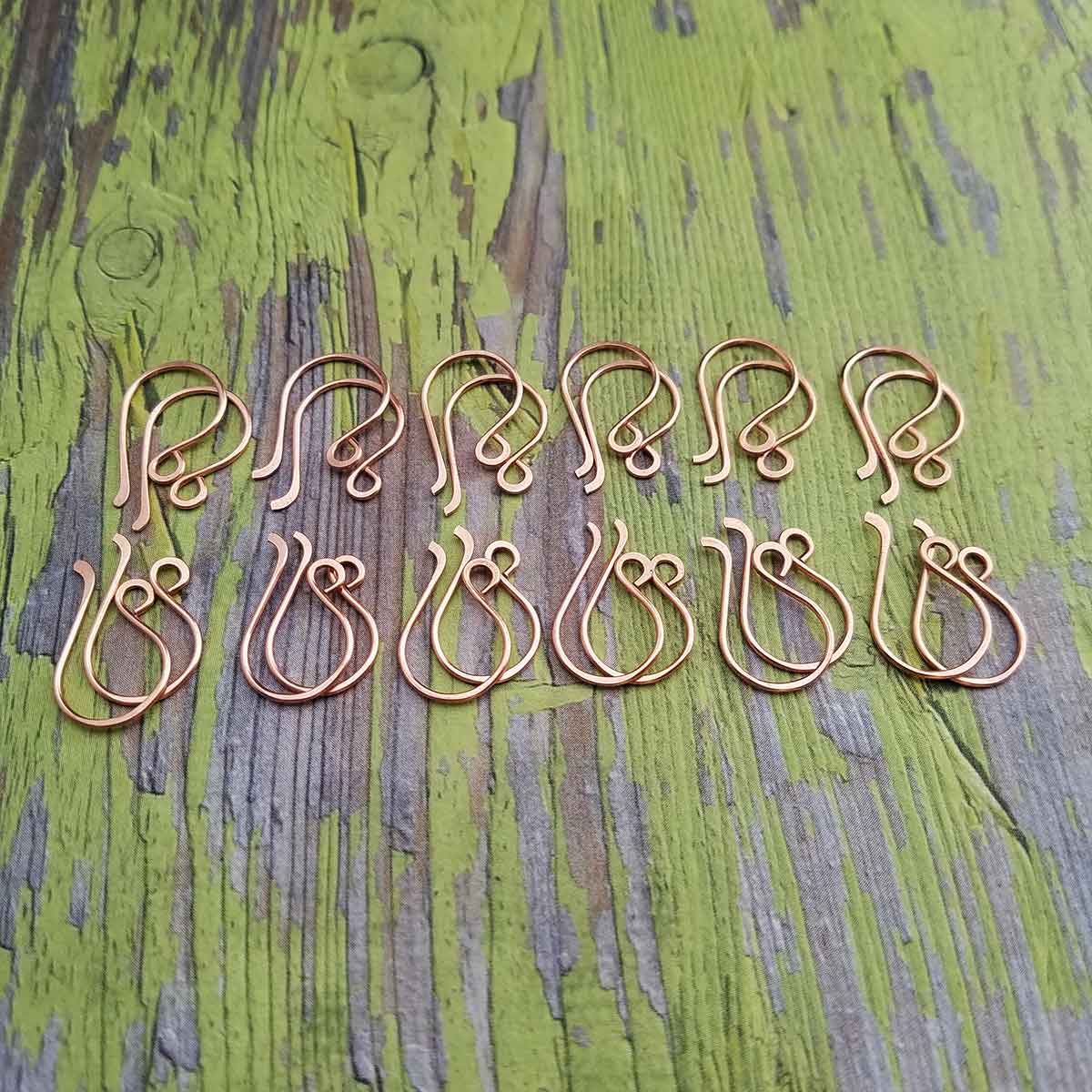
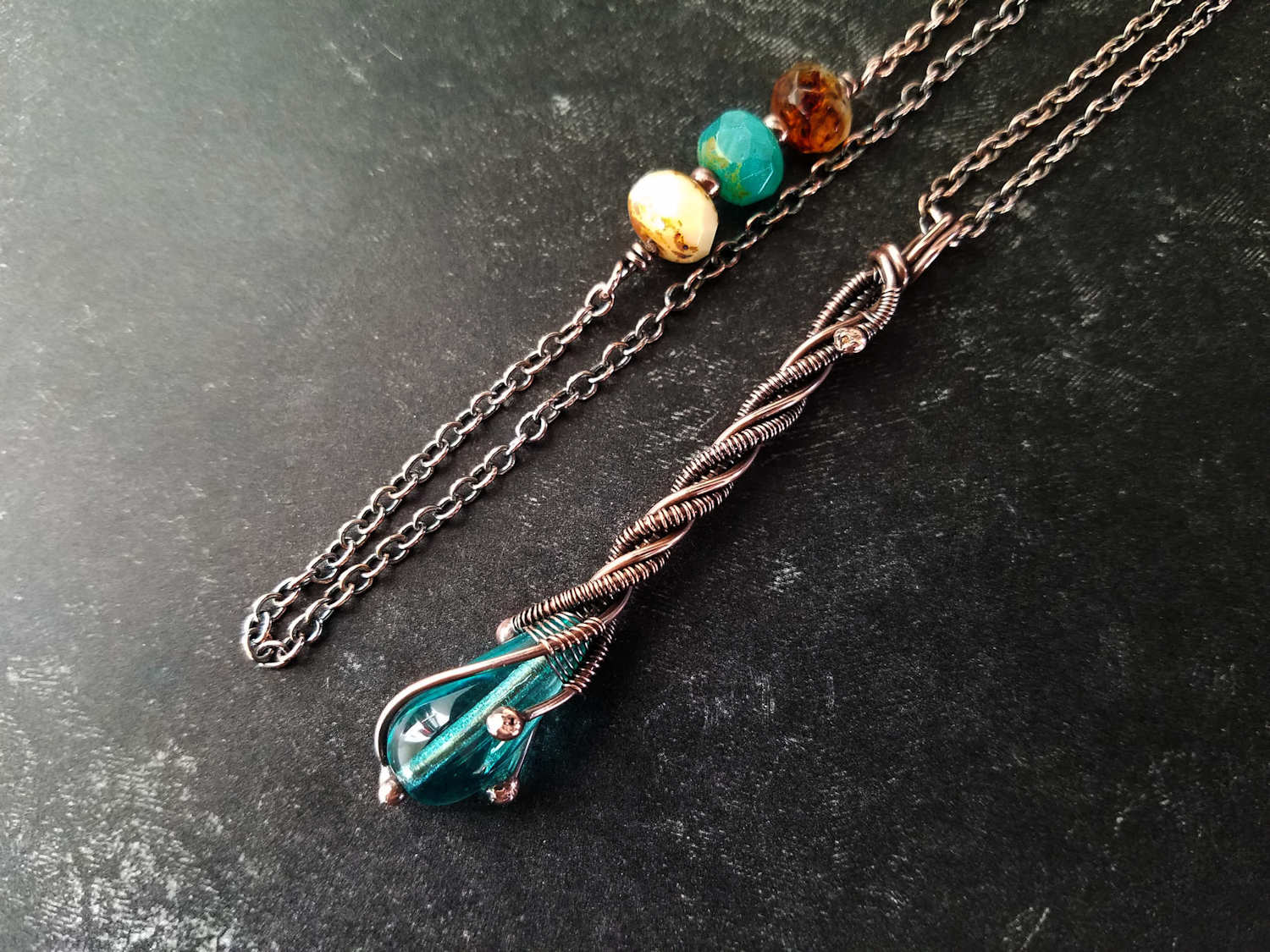
Thank You! I will try that one day!
You’re so welcome! 🙂
This is a great tutorial, so clear and helpful. Thank you! Your work is beautiful, I’m glad I found your site.
I’m so glad you enjoyed it, Tammy! Welcome. I’m glad you found my site too.